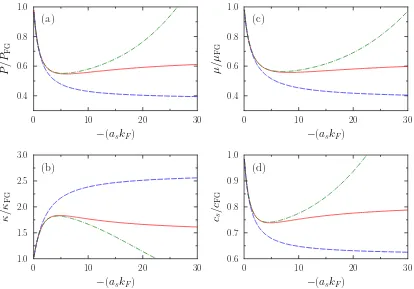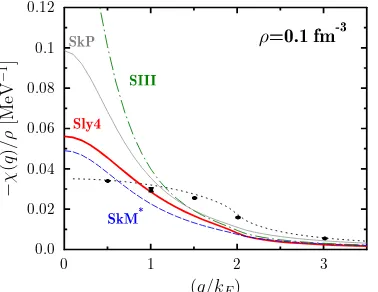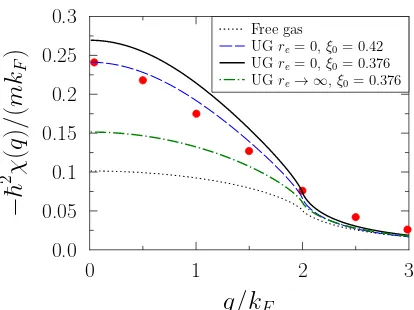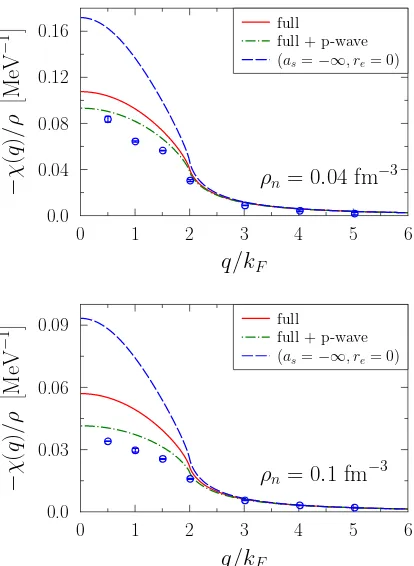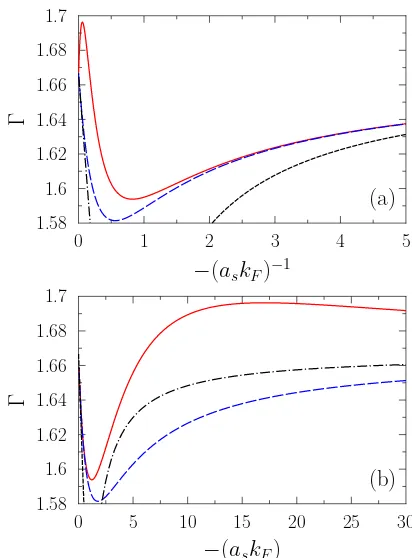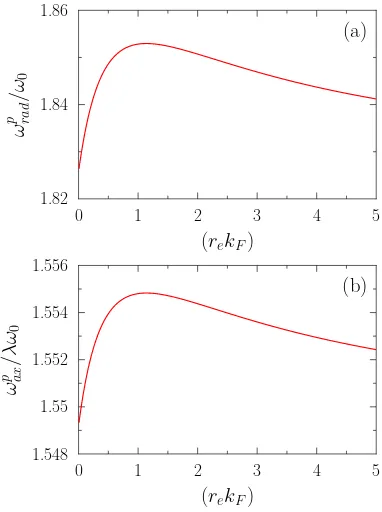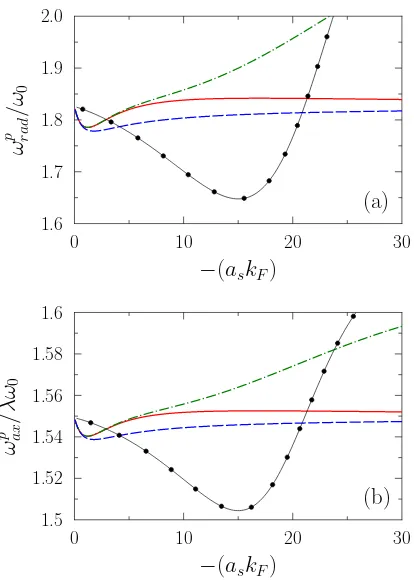A. Boulet∗ and D. Lacroix†
Institut de Physique Nucl´eaire, IN2P3-CNRS, Universit´e Paris-Sud, Universit´e Paris-Saclay, F-91406 Orsay Cedex, France
(Dated: September 18, 2017)
The thermodynamical ground-state properties and static response in both cold atoms at or close to unitarity and neutron matter are determined using a recently proposed Density Functional The-ory (DFT) based on thes-wave scattering lengthas, effective rangere, and unitary gas limit. In cold
atoms, when the effective range may be neglected, we show that the pressure, chemical potential, compressibility modulus and sound velocity obtained with the DFT are compatible with experimen-tal observations or exact theoretical estimates. The static response in homogeneous infinite systems is also obtained and a possible influence of the effective range on the response is analyzed. The neutron matter differs from unitary gas due to the non infinite scattering length and to a signifi-cant influence of effective range which affects all thermodynamical quantities as well as the static response. In particular, we show for neutron matter that the latter response recently obtained in Auxiliary-Field Diffusion Monte-Carlo (AFDMC) can be qualitatively reproduced when thep-wave contribution is added to the functional. Our study indicates that the close similarity between the exact AFDMC static response and the free gas response might stems from the compensation of the aseffect by the effective range andp-wave contributions. We finally consider the dynamical response
of both atoms or neutron droplets in anisotropic traps. Assuming the hydrodynamical regime and a polytropic equation of state, a reasonable description of the radial and axial collective frequen-cies in cold atoms is obtained. Following a similar strategy, we estimate the equivalent collective frequencies of neutron drops in anisotropic traps.
PACS numbers: 21.60.Jz, 03.75.Ss, 21.60.Ka, 21.65.Mn
Keywords: strongly interacting fermions, density functional theory, unitary limit
I. INTRODUCTION
The static and/or dynamical responses of many-body interacting systems give important information on the in-teraction between their constituents. In the last decade, important progresses have been made on the understand-ing of diluted cold atoms properties [1–4] with varyunderstand-ing s-wave scattering length, eventually reaching the unitary gas (UG) limit for which |askF|−1 → 0. Due to the
very large scattering length in neutron matter, these pro-gresses directly impact nuclear physics and offers the pos-sibility to address the nuclear many-body problem from a new perspective [5–7]. Another interesting progress in nuclear physics is the possibility to perform exact calcu-lations based on Quantum Monte-Carlo or other many-body techniques [8, 9]. However, contrary to the cold-atom case, while many efforts have been made to study the properties of nuclear Fermi systems in their ground states, very little is known from exact theories away from it. Very recently, the exact static response of neutron matter at various densities has been studied in Refs. [10, 11]. These benchmark calculations give new pieces of information on neutron matter and stringent constraints for other many-body approaches like the nuclear density functional theory (hereafter called Energy Density
Func-∗Electronic address: [email protected] †Electronic address: [email protected]
tional [EDF]). In particular, it was noted in Ref. [11], that the empirical Skyrme EDF leads to static response having significant differences with the exact case.
The recent work on ab-initio static response in neu-tron system together with the recently developed den-sity functional proposed in Refs. [5, 12] that makes a clear connection between cold atoms and neutrons sys-tems are the original motivations of this work. Starting from this functional, we first analyze the ground state thermodynamical properties of both cold atoms and neu-tron matter, some of them being directly linked to the static response. In particular, we underline the key role played in neutron matter by the effective range. We fi-nally conclude the work by an exploratory study of the collective response of cold atoms and neutron droplets in an anisotropic trap.
II. INTRODUCTION OF THE FUNCTIONAL
The functional proposed in Refs. [5, 12] may be written as:
E EFG ≡
ξ(askF, rekF),
= 1− U0
1−(askF)−1U1
+ R0(rekF)
[1−R1(askF)−1] [1−R1(askF)−1+R2(rekF)]
,
(1)
Low density+Unitary gas
TABLE I: Values of the different parameters entering in the functional. The parameters ξ0 (Bertsch parameter), ηe and δe are defined at the unitary limit (askF)−1 = 0 from the
constraintξ(askF → ∞, rekF)≡ξ0+ (rekF)ηe+ (rekF)2δe+
· · · with the values obtained in Ref. [13]: ξ0 = 0.376, ηe =
0.127 andδe=−0.055.
where ξ(askF, rekF) can be understood as a
generaliza-tion of the Bertsch parameter for finites-wave scattering lengthasand effective range re. EFGis the free Fermi–
gas (FG) energy given by:
EFG
whereNis the number of particles in a unit volumeV. In the present article, we will consider a infinite spin equi-librated system formed of one particle type only (cold atoms or neutrons). Then, the Fermi momentum kF is
linked to the densityρthroughρ=k3
F/(3π
2
). The differ-ent parameters are fixed by imposing specific asymptotic limits either in the low density regime (askF)→0 and/or
unitary limit−(askF)→+∞. Values of parameters
ob-tained in Ref. [12] are recalled in table I.
III. APPLICATION TO COLD ATOMS
The physics of cold atoms has attracted lots of atten-tion in the past decades [1–3]. One advantage in this case is the possibility to adjust the s-wave scattering length at will while, in some cases, effects of effective range and other channels can be neglected. Assuming first that re = 0, we end-up with the simple functional that
de-pends solely on the Bertsch parameter ξ0 in the unitary
regime. The great simplification of the DFT compared to other many-body theories stems from the fact that any quantity that could be written as a set of derivatives of the energy with respect of the density can be obtained in a straightforward manner. An illustration has been given in Ref. [5] with the Tan contact parameter [18– 20]. Below, we give other examples with ground-state thermodynamical quantities.
A. Ground state thermodynamical properties
Thermodynamical properties of atomic gases have been extensively studied both at zero and finite temper-ature [4]. In the present work, we concentrate on the
zero-temperature limit. Starting from a density func-tional approach, we summarize below the expression of selected quantities as a function of derivatives of the en-ergy in homogeneous systems:
• Pressure:
• Sound velocity and adiabatic index: From the above quantities one can deduce the sound velocity c2
s= (mρκ)−
1 and the adiabatic index
Γ = ρ
Alternative expressions can be obtained using directly the quantityξ introduced in Eq. (1) and its derivatives with respect to the Fermi momentum1
. These expres-sions are listed in table II together with specific limits obtained at or close to unitarity.
In the following, we will normalize these thermody-namical quantities to their corresponding values for the free FG case, given by:
PFG ≡ whereEFGis defined in equation (2).
Thermodynamical quantities obtained using the sim-ple functional for re = 0 and arbitrary large negative
1The derivatives with respect toρcan be transformed into
X/XFG E/EFG µ/µFG=µ
Close to unitary limit −(askF)−1→0
TABLE II: Summary of some useful relations for the ground state thermodynamical quantities. Top: expression of different quantities as a function of ξ, defined in Eq. (1) and its derivatives with respect to kF. Middle: Taylor expansion of the
functional in powers of (askF)−1 [re = 0 case], the parameters ζ and ν are linked to the functional parameters through ζ = (9π/10)(1−ξ0)2 ≃1.101 andν = (3/5)(9π/10)2(1−ξ0)3 ≃1.165 that are both close to 1 as found empirically in QMC
calculations [16, 17]. Bottom: Taylor expansion of Eq. (1) in powers of (rekF) at unitarity.
1
FIG. 1: The pressure (a), the inverse of the compressibility (b), the chemical potential (c) and the sound velocity (d) as function of−(askF)−1obtained from the functional (1) assumingre= 0 (blue long dashed line). The quantityP0is defined as
P0 = (µ/µFG)5/3PFG. For comparison, different experimental data or theoretical estimates are shown: (a) black filled circles
0.4 0.6 0.8 1.0
P
/P
F
G
0 1 2 3 4 5
−(askF)−1
(a)
0.4 0.6 0.8 1.0
P
/P
F
G
0 5 10 15 20 25 30
−(askF)
(b)
FIG. 2: Pressure as a function of−(askF)−1(a) or as a
func-tion of−(askF) (b) obtained from the functional (1) assuming re= 0 fm (blue long dashed line). For comparison, the black
short dashed and the black short dot-dashed lines correspond to the Taylor expansion to first order in (askF) or to first
or-der in (askF)−1 respectively. The red solid line corresponds
to the neutron matter case assumingre = 2.716 fm. In both
cases,as=−18.9 fm.
scattering length are compared in Fig. 1 with various experimental observations and/or theoretical estimates. Not surprisingly, the functional reproduces the unitary limit since it has explicitly been adjusted to reproduce the Bertsch parameterξ0. We see that, despite its
sim-plicity and the fact that the functional only depends on ξ0, it is able to reproduce rather well the
thermodynam-ics of Fermi–gas away from unitarity. It should be noted that none of the Taylor expansions in (askF) or (askF)−1
would be able to reproduce these quantities from very low to very high densities, as illustrated in Fig. 2 for the pressure. Similar behavior is obtained for the other quantities shown in Fig. 1.
B. Non-zero effective range effect
In Fig. 2, we also show an example of evolution of thermodynamical quantities for non-zero effective range relevant for neutron matter. In the present functional, the effect of re is mainly visible at large (askF) values,
i.e. close to unitarity. To illustrate the dependence with re, we consider the strict unitary limit. In that case, the
0.4 0.5 0.6
X
/X
F
G
0 1 2 3 4 5
(
rekF
)
ξ
0FIG. 3: The pressure [X = P] (blue solid line), chemical potential [X=µ] (red dashed line) and inverse compressibil-ity [X = 1/κ] (green dot-dashed line) obtained at unitarity using the functional (8) as a function of (rekF). The arrow
indicates the unitary limit forre= 0.
ξfunction depends only on (rekF) and we deduce:
ξ(askF →+∞, rekF) = ξ0+ η2
e(rekF)
ηe−δe(rekF)
, (8)
from which all thermodynamical quantities can be cal-culated. The effect of the effective range is predicted to increase the apparent Bertsch parameter leading also to an increase of the thermodynamical quantities at unitar-ity. This is illustrated in Fig. 3 for the pressure, the chemical potential and the inverse of the compressibility. We see in particular that the maximal value ofξat uni-tarity isξ0−ηe2/δe= 0.66 which is almost twice the value
ofξ0 and therefore might be significant.
C. Ground state thermodynamics of neutron matter
We have extended the above study to the case of neu-tron matter for which we anticipate important influence of the effective range re as well as eventually of higher
order channels contributions when the density increases. The different thermodynamical quantities obtained using the functional (1) with realistic values of the low energy constant as and re are shown in Fig. 4. While at very
low density the different quantities are only slightly af-fected by effective range, we indeed observe at densities of interest in the nuclear context, i.e. ρ ≃ 0.05−0.15 fm−3
, differences with the cold atom case.
IV. STATIC RESPONSE IN FERMI LIQUIDS
0.4 0.6 0.8 1.0
P
/P
F
G
0 10 20 30
−
(
askF
)
(a)
1.0 1.5 2.0 2.5 3.0
κ
/κ
F
G
0 10 20 30
−
(
askF
)
(b)
0.6 0.7 0.8 0.9 1.0
c
s/c
FG
0 10 20 30
−
(
askF
)
(d)
0.4 0.6 0.8 1.0
µ
/µ
F
G
0 10 20 30
−
(
askF
)
(c)
FIG. 4: The pressure (a), the inverse of the compressibility (b), the chemical potential (c) and the sound velocity (d) obtained in neutron matter as function of−(askF) using the functional (1) (red solid line). The case withre= 0 (cold atom reference)
is displayed with blue dashed line. The green dot-dashed line corresponds to the result obtain by adding to the functional the leading order contribution of thep-wave (see text). In this figure, we useas= 18.9 fm andre= 2.716 fm so that−(askF) = 10,
20 and 30 correspond respectively toρ= 0.005, 0.040 and 0.135 fm−3
.
system to an external field. In general, the static re-sponse provides interesting insight about the complex in-ternal reorganization in strongly interacting Fermi liquids [30, 31]. The static or dynamical responses have been the subject of extensive studies in the context of nuclear den-sity functional theory [32–36] especially those based on the Skyrme EDF. As we will see, in the latter case, the static response strongly depends on the set of param-eters used in the Skyrme EDF. Recently, the ab-initio static response of neutron matter has been obtained us-ing AFDMC for the first time in Refs. [10, 11] givus-ing strong constraints on nuclear EDF. One surprising result is that the static response is very close to the free FG response. Below we make a detailed discussion on the static response obtained using the functional (1). Since the methodology to obtain the static response is already well documented [30, 31], we only give the important equations used thorough the article.
A. Generalities on static response
Let us consider a system described by a many-body Hamiltonian ˆH. A static external one-body field, de-noted byVextis applied to the system leading to a change
of its properties. The static response, denoted byχ con-tains the information on how the one-body density and total energy vary with the external field. χ is defined through:
ρ(r) = ρ0+
Z
d3
r′χ(r−r′)Vext(r′), (9)
or equivalently
χ(r−r′) =
δρ(r)
δVext(r′)
, (10)
whereρ(r) denotes the local one-body density, while ρ0
is the equilibrium density of the uniform system in its ground state. Performing the Fourier transform of Eq. (9), we simply have:
Following Refs. [10, 11], we assume Vext(r) =
2P
qvqcos(q·r). The Fourier transform of Vext at q
is then simply a constant and we have for the energy:
E(q) = E0+ χ(q)
ρ0 v2
q+· · · (12)
The static response function is directly linked to the compressibilityκdiscussed above due to the asymptotic relationship:
lim
q→0χ(q) =−ρ 2
κ. (13)
The function χ(q) or its dynamical equivalent has been extensively studied for the Skyrme EDF [36]. In Fig. 5, we give examples of results obtained using different sets of Skyrme parameters and compared them with the AFDMC results of Refs. [10, 11]. It is clear from this figure that there is a large dispersion in the Skyrme EDF response depending on the parameter sets. Such a dispersion is not surprising since it is well known that the neutron equation of state is weakly constrained in Skyrme EDF (see for instance [38]). In all cases, even if the Skyrme EDF gives reasonable neutron matter EOS, significant difference is observed with the exact AFDMC result for all ranges of q/kF. This figure also illustrates
the fact that the exact result is very close to the free Fermi–gas response.
FIG. 5: Static response of neutron matter at densityρ= 0.1 fm−3
obtained with the Skyrme EDF using the Sly4 (red thick solid line), SkM∗(blue dashed line), SkP (gray thin solid line)
and SIII (green dot-dashed line) sets of Skyrme parameters (see [37] for their values). Note that the EDF results are ob-tained by neglecting the spin–orbit term in the functional. Adding the spin–orbit contribution does not change signifi-cantly the result. The black circles (with errorbars) are those of Ref. [11] while the black dotted line is the free Fermi–gas static response.
An important ingredient of the response in Skyrme EDF is the evolution of the effective mass as a function of the density. Such evolution is shown in Fig. 6(a). Again, large differences are observed between the different sets of Skyrme EDF. We also show for comparison, the effec-tive mass obtained in neutron matter using alternaeffec-tive
many-body techniques. In these cases, the deduced effec-tive mass are closer to the bare mass but still significantly differ with each other.
0.6
FIG. 6: (a) Evolution of the effective massm∗/min neutron
matter as a function of−(askF) (withas=−18.9 fm) using
Skyrme EDF for the set of parameters used in Fig. 5 with the same lines convention. (b) Evolution of the effective mass in neutron matter deduced from selected many-body calcula-tions: blue triangles [39], red circles [40], green squares [41], black diamonds [42].
In the absence of clear guidance for the effective mass behavior, we simply assume below that m∗/m = 1. Then, the calculation of the static response within the density functional approach reduces to
χ(q) = χ0(q) 1−G(ρ)χ0(q)
, (14)
whereχ0(q) is the response of the free gas given in term
of the Lindhard function (dashed line in Fig. 5)
χ0(q) = −
through:
E =
Z
{K(r) +V(r)}d3 r,
where K is the kinetic energy density and V is the po-tential energy density. For uniform system,G(ρ) is given by:
that could again eventually be transformed as partial derivatives with respect tokF.
1. Static response in unitary gas
0.0
FIG. 7: Static response of unitary gas (UG) obtained with the functional (8) assuming re = 0 (black solid line) or re → +∞ (green dot-dashed line). The latter case
corre-sponds to the maximum effect induced byreand corresponds
to an effective Bertsch parameter equal to 0.66. The free Fermi–gas response (black dotted line) is also shown as a ref-erence. For comparison, the red filled circles corresponds to the static response at unitarity obtained in ref. [43] using the SLDA where a slightly different value of the Bertsch pa-rameter ξ0 = 0.42 was assumed. For completeness, we also
show (blue dashed line) the UG result obtained with (8) for ξ0= 0.42.
We consider first the strict unitary gas limit withre=
0. In this case, we have
Using this expression, we obtain:
χ(q) = −mkπ2~F2
f(q/kF)
[1 + (ξ0−1)f(q/kF)]
(18)
wheref(q/kF) is defined through Eq. (15). In particular,
we see immediately that χ(0) =χ0(0)/ξ0, withχ0(0) = −mkF
π2~2 that is a direct consequence of the property (13)
and of the fact thatκFG/κ=ξ0in unitary gas (see table
II).
The full static response is shown in Fig. 7 and com-pared to the result obtained in Ref. [43] using the Su-perfluid Local Density Approximation (SLDA) proposed in Refs [22, 23]. The static response calculated with the functional (15) perfectly matches the SLDA result when the Bertsch parameter is artificially increased to match the one used in the SLDA. Note that, the SLDA assumed a significant contribution from the effective mass and ac-count also for superfluid effects, which is not the case in the present work. Therefore, an indirect conclusion is that the static response for UG does not seem to be significantly influenced in particular by superfluidity. We would like to insist on the fact that this is most probably specific to the response to a static field. Indeed, due to superfluidity, the dynamical response will present a low energy mode, the so-called Bogoliubov-Anderson mode, both seen experimentally [44] and theoretically [45].
The effect of re at unitarity can be studied using the
generalization of Eq. (17):
V(ρ) =EFG(ρ)[ξ(rekF)−1],
whereξ(rekF) is given by Eq. (8). The predicted
influ-ence of re is illustrated in Fig. 7. The effective range
induces a global reduction ofχ(q). The maximum effect is achieved by considering the limitre→+∞(green dot
dashed curve).
B. Static response in neutron matter
The neutron matter differs from the unitary gas by a finite value of the scattering length as well as significant effect of the effective range even at rather low density [12]. When the density increases, it is also anticipated that higher partial waves of the interaction contribute. Since our aim is to compare with the recent result of ref. [11] where the AV8 interaction has been used, we use the functional (1) using the AV8 values for the different parameters: as = −19.295 fm and re = 2.716 fm. We
note that, the functional (1) reproduces well the energy for rather low densitiesρ <0.02−0.03 fm−3 [12] while
the static responses of Ref. [11] have been obtained for ρ= 0.04 and 0.1 fm−3
which is not optimal for the com-parison.
We show in Fig. 8 the static response obtained from the functional (1) and compare it to the AFDMC results of Refs. [10, 11]. While slightly overestimated, especially in the highest density considered, we first observe that the new functional is in much better agreement than the empirical functional considered in Fig. 5. For the consid-ered densities, as underlined in Ref. [12], the functional (1) can be accurately replaced by its unitary gas limit, i.e. taking−(askF)−1 = 0. Indeed, replacingξentering
in the full functional byξ given by Eq. (8) leads almost to the same total energy and static response (not shown). Still, the static response obtained by neglecting there
the physical re, underlying the key role played by the
effective range.
Following Ref. [12], we also study the possible influ-ence of thep-wave contribution by adding simply its lead-ing order contribution to the energy, that is
Ep
The results are displayed in Fig. 8. We see that the p -wave term significantly contributes to the static response and, most importantly, the result is very close to the ab-initio one. For the sake of completeness, we also report in Fig. 4 the different thermodynamical quantities ob-tained by including thep-wave term. As noted already in Ref. [12], the inclusion of the leading term of the p -wave, produces a rather large, most probably unphysical, contributions to the different quantities and when den-sity increases one should a priori make a resummation of thep-wave effect that is out of the scope of the present work.
Finally, to systematically quantify the effects of finite as, influence of re and p-wave, we have reproduced the
Fig. 15 of Ref. [11] where the normalized response func-tion is shown for different densities (Fig. 9). In this figure, we can clearly see the importance of the effective range and to a lesser extend, the slightly smaller effect of the p-wave. Still the free Fermi–gas case is the one that best reproduces the AFDMC result. However, this is most probably accidental in view of the strong inter-action at play in nuclear systems.
We finally would like to mention that we are unable with the present density functional to reproduce the strong increase of the response function as q → 0 that is observed in the AFDMC. This limit is directly con-nected to the compressibility (see Eq. (13)). The com-pressibilities predicted by our EDF areρκ= 0.108 MeV andρκ= 0.057 MeV atρ= 0.04 fm−3
andρ= 0.1 fm−3
respectively. These values are lower than those reported in Ref. [11] which are respectively ρκ= 0.19 MeV and ρκ= 0.089 MeV atρ= 0.04 fm−3 andρ= 0.1 fm−3.
V. COLLECTIVE RESPONSE IN THE
HYDRODYNAMICAL REGIME
We conclude this work by using previous results to study the collective excitations in cold atoms and neu-tron matter in the hydrodynamical regime. The hydrody-namical description of Fermi systems is well documented [46, 47] and we only give below the important steps. Our aim is to study the dynamical response of a system con-fined in a trap, describe by an external potential U(r). At equilibrium, the external field is counterbalanced by the internal pressure leading to the equilibrium equation:
∇2
P(r) = −m1∇[ρ0(r).∇U(r)], (19)
where ρ0 denotes the equilibrium density while P is
the pressure at equilibrium given by Eq. (3). We
0.0
FIG. 8: Static response function obtained with the func-tional (1) as function ofq/kF for (a)ρ= 0.04 fm−3 and (b) ρ= 0.1 fm−3
. The blue dashed line and red solid line cor-responds respectively to the UG case (cold atom reference) andre= 0.2716 (neutron matter case). Note that at the
den-sity considered, the UG case cannot be distinguished from the neutron matter assumingre= 0. At both densities, the
AFDMC results of Refs. [10, 11] are shown with blue open circles. The green dot-dashed line finally display the result obtained by adding thep-wave contribution to the functional (1). Consistently with the use of the AV8 interaction in the AFDMC calculation, we use a valuea3
p= 0.0916 fm for the p-wave scattering volume.
now consider small amplitude oscillations around equi-librium such thatρ(r, t) =ρ0(r) +δρ(r, t) withδρ(r, t) = ρ1eiωt+ h.c.. The linearization of the hydrodynamical
equation leads to the equation:
ω2
0(r) is the local sound velocity defined through: mc2
0(r)≡dP(r)/dρ0(r). This equation has been used in
several works to study collective oscillations in Fermi–gas around unitarity [47–50]. Below we extend these studies by considering possible effect of non-zeroreand by going
0.0 0.05 0.1 0.15 0.2 0.25
−
χ
(
q
=
k
F)
/ρ
Me
V
−
1
0.02 0.04 0.06 0.08 0.1 0.12
ρ
fm
−3free gas full
full + p-wave
(as=−∞, re= 0)
FIG. 9: Evolution of the normalized static response as a func-tion of density forq=kF (same as Fig. 15 of Ref. [11]). The
AFDMC results of Ref. [11] is shown by blue open circles. The result of the functional (1) withre= 2.176 fm andre= 0
fm are shown by red solid and blue dashed line respectively. The result obtained by adding thep-wave contribution to the functional is shown by green dashed line. The black dot-ted line corresponds to the free Fermi–gas limit.
A. Adiabatic index in cold atoms and neutron matter
For the sake of simplicity, we assume that the system has a polytropic equation of state, i.e. that we simply have:
P(r)∝ρΓ0(r), (21)
where Γ is the adiabatic index in the center of the trap-ping potential. As in infinite system, we have the relation Γ = (κcPc)−1 where Pc andκc denote the pressure and
the compressibility in the center of the trapping potential at equilibrium given by Eqs. (3) and (5). The quantity Γ has been studied in cold atoms for varying−(askF) in
Ref. [16]. For vanishingre, it is know that Γ→5/3 both
in the unitary limit and in the low density regime. For UG, whenre could not be neglected anymore, using the
functional (8), we predict that Γ will deviate from 5/3. The dependence of Γ with the effective range is shown in Fig. 10. We see that Γ first increases and then decreases. In the extreme limitre→+∞, it is possible to show that
we again obtain Γ→5/3.
More generally, we illustrate the dependence of Γ ob-tained with or without effective range effects in Fig. 11 for low energy constants taken from neutron matter. For re= 0, we qualitatively and quantitatively reproduce the
result of Ref. [16] with the presence of a minimum in Γ for
−2.5<(askF)<0. While the minimum persists for
non-vanishingre, we observe that it is slightly shifted to lower
values of|askF|. Overall, we see thatresignificantly
af-fects the evolution of Γ that now presents a maximum and approaches Γ = 5/3 from above as−(askF)→+∞.
1.66 1.68 1.7 1.72
Γ
0 1 2 3 4 5
(
rekF
)
ξ
0FIG. 10: Evolution of the non-adiabatic index Γ at unitarity (red solid line) deduced from the functional (8) as a function of (rekF). The arrow indicates the unitary limit for re = 0.
For comparison, the black short dashed line corresponds to the Taylor expansion ofξto second order in (rekF).
1.58 1.6 1.62 1.64 1.66 1.68 1.7
Γ
0 1 2 3 4 5
−
(
a
sk
F)
−1(a)
1.58 1.6 1.62 1.64 1.66 1.68 1.7
Γ
0 5 10 15 20 25 30
−
(
a
sk
F)
(b)
FIG. 11: Same as Fig. 2 for the adiabatic index.
B. Collective frequencies in anisotropic trap
As shown in Ref. [48], assuming polytropic equation of state leads to rather simple expression of the collec-tive oscillations in deformed systems. More precisely, we consider here a system confined in an anisotropic trap
U(r) =m 2ω
2 0 x
2
+y2
+λ2 z2
where λ gives a measure of the anisotropy, with λ < 1 andλ >1 for prolate or oblate deformations respectively. Then Heiselberg [48] has obtained analytical expression for the collective frequencies along the elongation axis or perpendicular to the elongation axis. This collective axis are called below axial or radial collective frequencies and are denoted byωax andωrad respectively.
For prolate deformation withλ≪1, the two frequen-cies are given by:
ωaxp ω0
= λ
r
3−Γ1, (23)
ωradp ω0
= √2Γ, (24)
while in the oblate limitλ≫1, we have: ωo
ax ω0
= λ√Γ + 1, (25)
ωo
rad ω0
= r
6Γ−2
Γ + 1. (26)
Note that for λ = 1 we recover results obtained for isotropic trap [48, 51]. We then see that a change in Γ will be reflected by a change in the axial and radial col-lective frequencies. The colcol-lective response of cold atoms
1.52 1.53 1.54 1.55 1.56 1.57
ω
p ax/λ
ω0
0.0 0.25 0.5 0.75 1.0
−(askF)−1
(b) 1.7
1.75 1.8 1.85 1.9
ω
p rad
/ω
0
0.0 0.25 0.5 0.75 1.0
−(askF)−1
(a)
FIG. 12: ωradp /ω0 (a) and ωaxp /(λω0) (b) as function of
−(askF)−1obtained with the functional (1) withre= 0 (blue
dashed line). The symbols are experimental data: triangles from [52], circles from [53] and squares from [54]. (All data sets are taken from Fig. 3 of Ref. [55])
with possible anisotropy for the trapping potential has
attracted much attention in the last decades. The ex-perimental axial and radial frequencies are shown at or around unitarity for prolate shapes in Fig. 12. At unitar-ity (Γ = 5/3), we expect to haveωp
ax/(λω0) =
p 12/5 ≃
1.549 and ωprad/ω0 =
p
10/3 ≃ 1.826 that seems coher-ent with the observations. In Fig. 12, we also display the results of Eqs. (24) and (23). using the adiabatic index obtained from the functional (1) with re = 0. We see
that the estimated collective frequencies are consistent with the observation in cold atoms. We then investigate the possible effect of re in the strict unitary regime in
Fig. 13. In this case, the Γ that is used in Eqs. (24-23) is displayed in Fig. 10. We see a rather weak dependence of the collective frequencies withre.
1.82 1.84 1.86
ω
p rad
/ω
0
0 1 2 3 4 5
(rekF)
(a)
1.548 1.55 1.552 1.554 1.556
ω
p ax/λ
ω0
0 1 2 3 4 5
(rekF)
(b)
FIG. 13: ωradp /ω0(a) andωaxp/(λω0) (b) as function of (rekF)
obtained with the functional (1) at unitarity (askF)−1= 0.
1.6 1.7 1.8 1.9 2.0
ω
p rad
/ω
0
0 10 20 30
−
(
askF
)
(a)
1.5 1.52 1.54 1.56 1.58 1.6
ω
p ax
/λ
ω
00 10 20 30
−
(
askF
)
(b)
FIG. 14: ωradp /ω0(resp. ωaxp/ω0) as a function of−(askF) (a)
(resp. (b)) obtained in neutron matter usingas=−18.9 fm
andre= 2.716 fm (red solid line) in the functional (1) while
the blue long-dashed line corresponds to the result obtained with re = 0. For comparison, we also show the result of
the Skyrme Sly5 parameter sets (black filled circles) and the result obtained by adding to the functional the leading order p-wave contribution (green dot-dashed line).
VI. CONCLUSION
In the present work, we make a detailed analysis of thermodynamical ground-state properties of both cold
atoms and neutron matter starting from the new density functional proposed in Refs. [5, 12]. For cold atoms with large negative s-wave scattering length and with negli-gible effective range effects, thermodynamical quantities like the pressure, the chemical potential, the compress-ibility and zero sound are very well reproduced. We fur-ther analyze the possible influence of the effective range at and away from the unitary gas limit. The inclusion of effective range is the first step towards the proper descrip-tion of neutron matter. The difference between ground-state thermodynamical properties in UG and neutron matter are quantified.
The thermodynamical quantities, and more specifically the compressibility are connected to the static response of Fermi liquids to an external constraint for which ex-act AFDMC exists [10, 11]. The exex-act static response is obtained using the new functional. It is shown to be in much better agreement with AFDMC result than the Skyrme type functional especially at low density.
We finally consider the dynamical collective response in the hydrodynamical regime. In the cold atom case, a reasonable description of radial and axial collective fre-quency is obtained assuming a polytropic equation of state. Following a similar strategy, we estimate the col-lective frequencies of neutron drops in anisotropic traps. Important differences are observed between Skyrme em-pirical functional and the new functional discussed here.
Acknowledgments
The authors thanks J. Bonnard, A. Gezerlis, M. Grasso, C.-Y. Yang for useful discussion at different stage of the work. D. L. also thank A. Pastore for cross-checking and his help in obtaining the result for the response with Skyrme functional. This project has re-ceived funding from the European Unions Horizon 2020 research and innovation program under grant agreement No. 654002.
[1] I. Bloch, J. Dalibard and W. Zwerger, Rev. Mod. Phys.
80, 885 (2008).
[2] S. Giorgini, L. P. Pitaevskii and S. Stringari Rev. Mod. Phys.80, 1215 (2008).
[3] C. Chin, R. Grimm, P. Julienne and E. Tiesinga Rev. Mod. Phys.82, 1225 (2010).
[4] W. Zwerger, ed. The BCS-BEC crossover and the uni-tary Fermi–gas.Vol.836. Springer Science and Business Media, (2011).
[5] D. Lacroix, Phys. Rev. A94, 043614 (2016).
[6] I. Tews, J. M. Lattimer, A. Ohnishi, E. E. Kolomeitsev, arXiv:1611.07133.
[7] S. K¨onig, H. W. Griesshammer, H.-W. Hammer, and U. van Kolck Phys. Rev. Lett.118, 202501 (2017).
[8] J. Carlson, S. Gandolfi and A. Gezerlis, Prog. Theor.
Exp. Phys. 01A209 (2012).
[9] S. Gandolfi, A. Gezerlis and J. Carlson, Annu. Rev. Nucl. Part. Sci.65, 303 (2015).
[10] M. Buraczynski and A. Gezerlis, Phys. Rev. Lett.116, 152501 (2016).
[11] M. Buraczynski and A. Gezerlis, Phys. Rev. C95, 044309 (2017).
[12] D. Lacroix, A. Boulet, M. Grasso and C. J. Yang, Phys. Rev. C95, 054306 (2017).
[13] M. M. Forbes, S. Gandolfi and A. Gezerlis, Phys. Rev. A
86, 053603 (2012).
[14] T.D. Lee and C.N. Yang, Phys. Rev.105, 1119 (1957). [15] R. F. Bishop, Ann. Phys.77, 106 (1973).
[17] G. E. Astrakharchik, J. Boronat, J. Casulleras and and S. Giorgini, Phys. Rev. Lett.93, 200404 (2004). [18] S. Tan, Ann. Phys. (N.Y.)323, 2952 (2008). [19] S. Tan, Ann. Phys. (N.Y.)323, 2971 (2008). [20] S. Tan, Ann. Phys. (N.Y.)323, 2987 (2008).
[21] N. Navon, S. Nascimbene, F. Chevy and C. Salomon, Science328, 729 (2010).
[22] A. Bulgac, Phys. Rev. A76, 040502 (2007).
[23] A. Bulgac, J. Drut, P. Magierski, Phys. Rev. A 78, 023625 (2008).
[24] H. Hu, X. Liu and P. Drummond, Europhys. Lett. 74, 574 (2006).
[25] R. Haussmann, W. Rantner, S. Cerrito and W. Zwerger, Phys. Rev. A75, 023610 (2007).
[26] P. Pieri, L. Pisani and G. C. Strinati, Phys. Rev. B72, 012506 (2005).
[27] M. Horikoshi, M. Koashi, H. Tajima, Y. Ohashi and M. Kuwata-Gonokami, (2016), arXiv:1612.04026 [cond-mat.quant-gas].
[28] W. Weimer, K. Morgener, V. P. Singh, J. Siegl, K. Hueck, N. Luick, L. Mathey and H. Moritz, Phys. Rev. Lett.114, 095301 (2015).
[29] J. Joseph, B. Clancy, L. Luo, J. Kinast, A. Turlapov and J. E. Thomas, Phys. Rev. Lett.98, 170401 (2007). [30] D. Pines and P. Nozi`eres,The Theory of Quantum
Liq-uids, (Benjamin, Reading, 1966), Vol. I.
[31] C.Kittel, Introduction to solid state physics, (Wiley, 2005).
[32] C. Garc´ıa-Recio, J. Navarro, Van Giai Nguyen, L.L. Sal-cedo, Ann. of Phys. ,214, 293 (1992).
[33] A. Pastore, D. Davesne, Y. Lallouet, M. Martini, K. Ben-naceur and J. Meyer, Phys. Rev. C85, 054317 (2012). [34] A. Pastore, M. Martini, V. Buridon, D. Davesne, K.
Ben-naceur and J. Meyer, Phys. Rev. C86, 044308 (2012). [35] A. Pastore, K. Bennaceur, D. Davesne and J. Meyer, Int.
J. Mod. Phys. E21, 1250040 (2012).
[36] A. Pastore, D. Davesne and J. Navarro, Phys. Rep.563,
1 (2015).
[37] J. Meyer, Ann. Phys. Fr23, 1 (2003).
[38] B. Alex Brown, Phys. Rev. Lett.85, 5296 (2000). [39] A. Schwenk, B. Friman and G.E. Brown, Nucl. Phys. A
713, 191 (2003).
[40] J. Wambach, T.L. Ainsworth, D. Pines, Nucl. Phys. A
555(1993) 128.
[41] B. Friedman and V. Pandharipande, Nucl. Phys. A361, 502 (1981).
[42] C. Drischler, V. Som`a, and A. Schwenk Phys. Rev. C 89, 025806 (2014).
[43] M. M. Forbes and R. Sharma, Phys. Rev. A90, 043638 (2014).
[44] S. Hoinka, M. Lingham, M. Delehaye and C. J. Vale, Phys. Rev. Lett. bf 109, 050403 (2012).
[45] G. E. Astrakharchik, J. Boronat, E. Krotscheck and T. Lichtenegger, J. Phys. Conf. Ser.529, 012009 (2014). [46] E. Lipparini, Modern Many-Particle Physics: Atomic
Gases, Quantum Dots and Quantum Fluids, World Sci-entific Publishing Co Inc, (2008).
[47] S. Stringari, Phys. Rev. Lett.77, 2360 (1996). [48] H. Heiselberg, Phys. Rev. Lett.93, 040402 (2004). [49] Aurel Bulgac and George F. Bertsch, Phys. Rev. Lett.
94, 070401 (2005).
[50] S. K. Adhikari, Phys. Rev. A77, 045602 (2008). [51] Marco Cozzini and Sandro Stringari, Phys. Rev. Lett.
91, 070401 (2003)
[52] M. Bartenstein, A. Altmeyer, S. Riedl, S. Jochim, C. Chin, J. H. Denschlag and R. Grimm, Phys. Rev. Lett.
92, 203201 (2004).
[53] J. Kinast, A. Turlapov and J. E. Thomas, Phys. Rev. A
70, 051401 (2004).
[54] J. Kinast, S. L. Hemmer, M. E. Gehm, A. Turlapov and J. E. Thomas, Phys. Rev. Lett.92, 150402 (2004). [55] N. Manini and L. Salasnich, Phys. Rev. A71, 033625
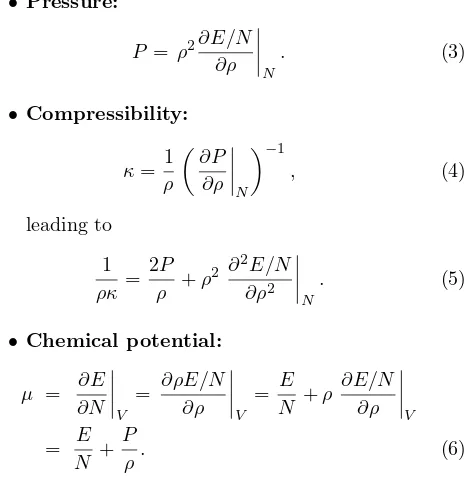
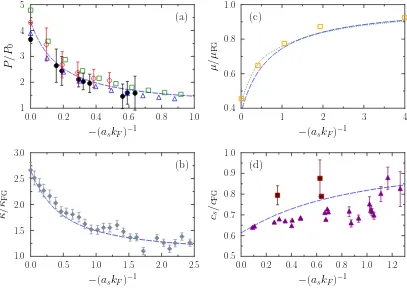
![FIG. 3:The pressure [indicates the unitary limit forusing the functional (8) as a function of (ity [potential [X = P] (blue solid line), chemicalX = µ] (red dashed line) and inverse compressibil-X = 1/κ] (green dot-dashed line) obtained at unitarityrekF )](https://thumb-ap.123doks.com/thumbv2/123dok/2962521.1356455/4.612.86.268.58.314/indicates-forusing-functional-function-potential-chemicalx-compressibil-unitarityrekf.webp)
